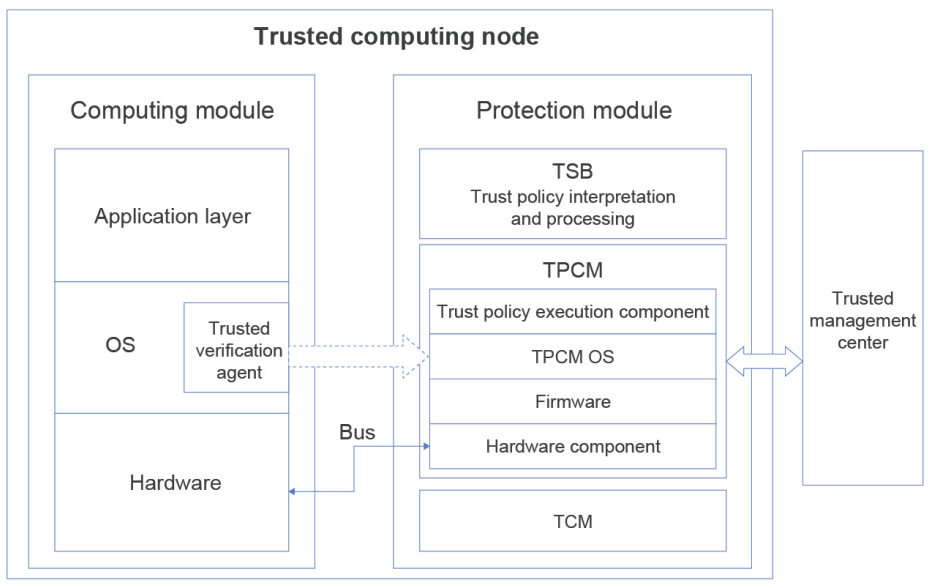Trusted Platform Control Module
Background
Trusted computing has undergone continuous development and improvement in the past 40 years and has become an important branch of information security. Trusted computing technologies have developed rapidly in recent years and have solved the challenges in Trusted Computing 2.0—integration of trusted systems and existing systems, trusted management, and simplification of trusted application development. These technical breakthroughs form Trusted Computing 3.0, that is, trusted computing based on an active immune system. Compared with the passive plug-in architecture of the previous generation, Trusted Computing 3.0 proposes a new trusted system framework based on self-controlled cryptography algorithms, control chips, trusted software, trusted connections, policy management, and secure and trusted protection applications, implementing trust across the networks.
The trusted platform control module (TPCM) is a base and core module that can be integrated into a trusted computing platform to establish and ensure a trust source. As one of the innovations in Trusted Computing 3.0 and the core of active immunity, TPCM implements active control over the entire platform.
The TPCM-based Trusted Computing 3.0 architecture consists of the protection module and the computing module. On the one hand, based on the Trusted Cryptography Module (TPM), the TPCM main control firmware measures the reliability of the protection and computing modules, as well as their firmware. On the other hand, the Trusted Software Base (TSB) measures the reliability of system software and application software. In addition, the TPCM management platform verifies the reliability measurement and synchronizes and manages the trust policies.
Feature Description
The overall system design consists of the protection module, computing module, and trusted management center software, as shown in the following figure.
Trusted management center: This centralized management platform, provided by a third-party vendor, formulates, delivers, maintains, and stores protection policies and reference values for trusted computing nodes.
Protection module: This module operates independently of the computing module and provides trusted computing protection functions that feature active measurement and active control to implement security protection during computing. The protection module consists of the TPCM main control firmware, TCB, and TCM. As a key module for implementing trust protection in a trusted computing node, the TPCM can be implemented in multiple forms, such as cards, chips, and IP cores. It contains a CPU and memory, firmware, and software such as an OS and trusted function components. The TPCM operates alongside the computing module and works according to the built-in protection policy to monitor the trust of protected resources, such as hardware, firmware, and software of the computing module. The TPCM is the Root of Trust in a trusted computing node.
Computing module: This module includes hardware, an OS, and application layer software. The running of the OS can be divided into the boot phase and the running phase. In the boot phase, GRUB2 and shim of openEuler support the reliability measurement capability, which protects boot files such as shim, GRUB2, kernel, and initramfs. In the running phase, openEuler supports the deployment of the trusted verification agent (provided by third-party vendor HTTC). The agent sends data to the TPCM for trusted measurement and protection in the running phase.
The TPCM interacts with other components as follows:
- The TPCM hardware, firmware, and software provide an operating environment for the TSB. The trusted function components of the TPCM provide support for the TSB to implement measurement, control, support, and decision-making based on the policy library interpretation requirements.
- The TPCM accesses the TCM for trusted cryptography functions to complete computing tasks such as trusted verification, measurement, and confidential storage, and provides services for TCM access.
- The TPCM connects to the trusted management center through the management interface to implement protection policy management and trusted report processing.
- The TPCM uses the built-in controller and I/O port to interact with the controller of the computing module through the bus to actively monitor the computing module.
- The built-in protection agent in the OS of the computing module obtains the code and data related to the preset protection object and provides them to the TPCM. The TPCM forwards the monitoring information to the TSB, and the TSB analyzes and processes the information according to the policy library.
Constraints
Supported server: TaiShan 200 server (model 2280)
Supported BMC card: BC83SMMC
Application Scenarios
The TPCM enables a complete trust chain to ensure that the OS boots into a trusted computing environment.
